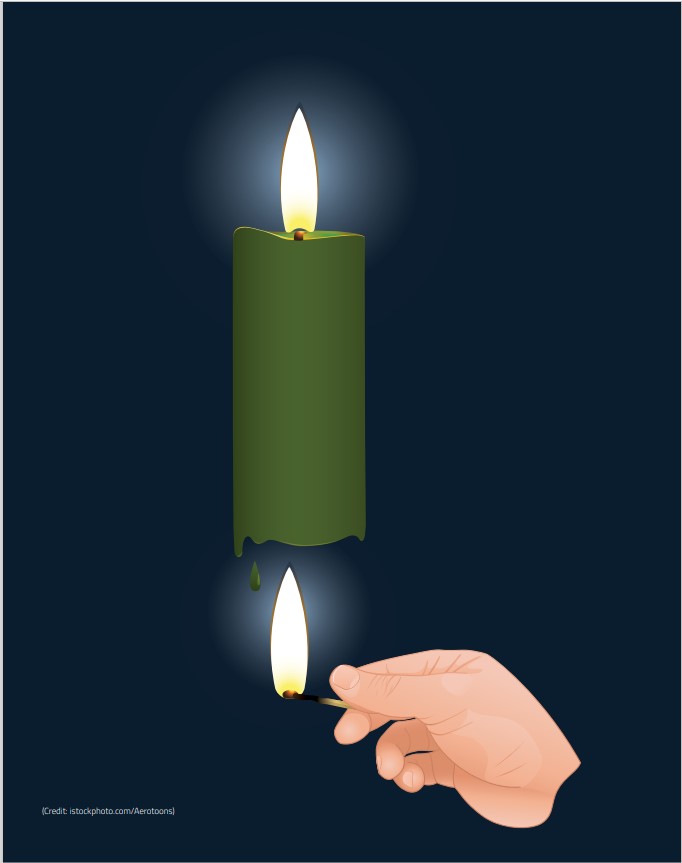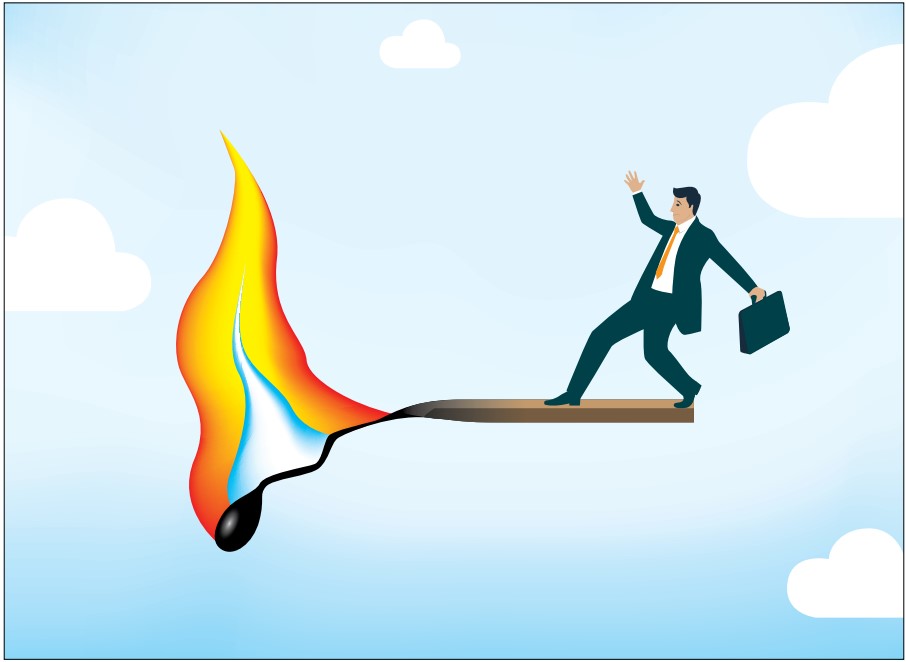
(Credit: istockphoto.com Aerotoons)
Preventing Burnout in the JAG Corps
By Major Rebecca A. Blood, Ph.D.
Army Strong.1 This concept has been ingrained in Soldiers for the last twelve years. It communicates the idea that Soldiers are the best of the best, that they can endure anything, they can accomplish anything, and that they are unstoppable. While this message is intended to be empowering, it also conveys an unintended message to troops: because you are the best of the best, you should place the mission first and put your distress to the side; address the distress later, once the mission is complete. While the Army is a formidable opponent, it is a collective; it is only solid as a team of individuals and as strong as its weakest link. Maintaining the fighting force is not accomplished by ignoring stressors and being able to “do it all”; rather, it is achieved by focusing on the individual in order to contribute to the greater mission.
According to a 2016 report by the Deployment Health Clinical Center, 26.4% of active duty Army members were diagnosed with a mental health disorder.2 That means nearly one in four Soldiers presented to a medical provider and was given a diagnosis such as adjustment disorder, depression, anxiety, or posttraumatic stress disorder. The Soldiers who sought services represent the full spectrum of occupational specialties. It is not only those working the “front line” in combat arms positions seeking treatment; rather, those looking for treatment include many administrative positions as well. In the last decade, the Army has bolstered its behavioral health resources, placing a psychologist and social worker in each brigade, establishing a free-standing embedded behavioral health clinic within the unit footprint. In addition to these proximate resources, Soldiers have the option to seek services at the installation hospital or receive an off-post referral.
Burnout
While the Army has made a pointed effort to increase the accessibility of behavioral health resources, there has been little focus on the concept of burnout. Burnout is a response to the interpersonal stresses of work with people who are in emotionally demanding situations.3 Compassion fatigue is the development of post traumatic stress symptoms subsequent to frequent exposure to sexual assault survivors.4 Burnout and compassion fatigue are examples of vicarious traumatization.5 In other words, it is the stress that results from working with individuals and hearing cases that involve traumatic situations and material. Symptoms resulting from compassion fatigue and burnout are commonly observed among doctors, nurses, and therapists. Anyone who works in a “helping profession,” such as medical providers or in the legal system, is at increased risk of developing symptoms. Other risk factors for developing compassion fatigue include increased empathy with the client, decreased social support, increased workload, working with child victims, and prior personal history of trauma.
While the majority of the research focuses on helping professionals such as therapists or police officers, there have been several studies examining an attorney population. One study discovered that attorneys showed significantly higher rates of compassion fatigue and burnout than behavioral health providers or social service workers.6 It was posited that the higher rates were attributed to higher caseloads and little education regarding trauma and its effects.7 Individuals in the Judge Advocate General’s (JAG) Corps are not typically the Soldiers who are seeking behavioral health services. What prevents judge advocates from seeking services is unclear. One could opine that it is due to available time, stigma, fear of career-impacting negative consequences, or simply not having the requisite information.

(Credit: istockphoto.com enisaksoy)
The JAG Corps is a unique population. Simply due to status as a military member, attorneys are at increased risk of developing compassion fatigue symptoms. In addition, unlike civilian counterparts practicing in the private sector, military attorneys are not typically afforded the opportunity to select their cases. Additionally, given that sexual assault crimes are frequently litigated, exposure to sex crimes heightens the risk even further. Whether in the role of trial counsel, defense counsel, special victim prosecutor, or special victim counsel, attorneys are continuously exposed to difficult material in case files. Repeated exposure to sex crimes or child pornography can lead to an accumulation of material that is difficult to process. Furthermore, attorneys who are directly interacting with victims of sex-related crimes may begin to internalize the emotional response and symptoms of the victim.
Signs of Burnout
Learning to recognize the signs of burnout is one of the first steps in combating the development of symptoms. Signs of approaching burnout include being overly cynical, increased irritability, decreased energy, decreased motivation, decreased work satisfaction, and feeling disillusioned about work.8 Burnout can place an individual at increased risk for developing post-traumatic stress symptoms.9 That means an attorney who is experiencing burnout and also repeatedly working with sex crimes cases is at risk for developing vicarious traumatization. The effects may not be readily apparent. Some of these experiences may include:
- Aligning with one side of the bar over another
- Feeling hopeless and helpless
- Having a negative outlook
- Experiencing difficulty engaging in intimate interactions with a partner
- Having less patience with family
Quite often, the symptoms will appear gradually and, as a result, they may be more difficult to identify.
Mitigation
Research also identifies “learned helplessness” as an issue specific to the attorney population.10 Learned helplessness is when a person has a sense of powerlessness, after enduring repeated aversive stimuli beyond their control.11 To some extent, you have little control over the size and type of your caseload. It may feel “pointless” to seek therapy to address work-related stress. Imagine that each client or each case (in addition to any other stressors in your life) is a pebble. If you continue to put these pebbles in your “bucket,” at some point, the bucket will be unable to hold all of the pebbles. By addressing even the smallest of pebbles, enough that they do not remain in the bucket, you will be able to better manage the unavoidable stressors in your life. Taking (and making) the time to process this difficult material is an initial step in mitigating any long-lasting effects. Even though the Army has taken steps to de-stigmatize behavioral health, the stigma and myths about therapy persist. Therapy is merely a process of sharing stressors with an objective person. It can alleviate negative symptoms and lessen the burden on the individual. Many Soldiers choose to seek off-post therapy with non-DoD providers, as this can provide an additional layer of confidence and trust with regard to confidentiality.
The next point may sound routine; however, most Soldiers struggle with the concept of self-care. Engaging in enjoyable activities is essential to the practice of self-care. Exercising, using leave, taking vacations, spending time with family, reading, gaming, spending social time with friends—these are all important to maintain a balanced life. Engaging in just an hour of enjoyable activities every week can help to combat any negative effects from the repeated work with trauma and difficult material.
Further, using humor can moderate the effects of vicarious traumatization. “Gallows” humor is a term that has been researched for years due to its prevalence amongst emergency rescue workers and providers in emergency room departments.12 One can be horrified at case material, but find the absurdity in the details. For example, in our office, there was a case involving a man who had a body in his car trunk, but was focused on ordering “delicious” breadsticks. That case is now referred to as the “breadsticks case.” Was the crime itself terrible? Of course it was. However, when you are faced with only the most horrific crimes, you must find a way to deal with the difficult material. There is a delicate balance between being sensitive to difficult material and using humor as a coping method, but humor, appropriately used, can aid with the processing of terrible and tragic events. Overuse or inappropriate use of gallows humor can also be a sign of burnout. If you find your colleagues’ humor deviating into a disrespectful area, it could be time to pull your colleague aside and check in.
Early identification and mitigation of the effects of burnout and vicarious traumatization will result in increased life satisfaction. It could also result in increased career longevity and increased day-to-day efficiency. Being able to recognize the signs in oneself, as well as with colleagues, is paramount to the effectiveness of the Corps. Further, bonding together and having these conversations with your colleagues are the best ways to combat compassion fatigue. Being Army Strong does not translate to being able to do it all; rather, knowing your limitations and implementing self-care is the valued lesson. If you find yourself or a peer unable to cope with the stressors, reach out to one of the behavioral health folks in your footprint. Even if you do not want to meet with the behavioral health personnel in your unit, they can certainly provide you with alternative resources. Remember, the Army is a collective, a group of individuals with shared goals, and we are all here to help guide each other through this long and strange journey.TAL
MAJ Blood is a Forensic Psychology Postdoctoral Fellow at the Center for Forensic Behavioral Sciences, Walter Reed National Military Medical Center, Bethesda, Maryland.
Notes
1. Slogans of the United States Army , Wikipedia , https://en.wikipedia.org/wiki/Slogans_of_the_United_States_Army (last visited Oct. 8, 2019).
2. Department Health Clinical Center, Mental Health Disorder Prevalence Among Active Duty Service Members in the Military Health System, Fiscal Years 2005-2016 ( Jan. 2017), https://www.pdhealth.mil/sites/default/files/images/mental-health-disorder-prevalence-among-active-duty-service-members-508.pdf.
3. Christina Maslach, Burn-out , Human Behavior , Sept. 1976, at 16-22.
4. I. Lisa McCann & Laurie Anne Pearlman, Vicarious Traumatization: A Framework for Understanding the Psychological Effects of Working with Victims , J. Traumatic Stress, Jan. 1990, at 131-49.
5. Id.
6. Andrew Levin & Scott Greisberg, Vicarious Trauma in Attorneys , 24 Pace L. Rev. 245 .
7. Id.
8. Patrick Brady, Crimes Against Caring: Exploring the Risk of Secondary Traumatic Stress, Burnout, and Compassion Satisfaction Among Child Exploitation Investigators , 32 J. Police & Crim. Psychol. 305 (2017).
9. Id.
10. Majorie Silver, Sanford Portnoy, & Jean Koh Peters, Stress, Burnout, Vicarious Trauma, and Other Emotional Realities in the Lawyer/Client Relationship , 19 Touro L. Rev. 847 (2015).
11. Id.
12. Carmen Moran, Does the Use of Humour as a Coping Strategy Affect Stresses Associated with Emergency Work? , 8 Int’l J. Mass Emergencies & Disasters 361-77 (1990).